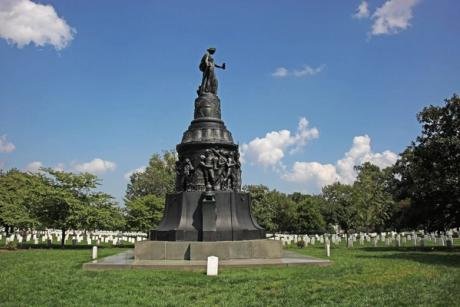
A day after issuing a temporary injunction, a federal judge ruled that workers could continue taking down a Confederate monument at Arlington National Cemetery near Washington, DC. The monument is scheduled to be removed by the end of the week, and will be put into storage until its fate is decided.
The US Department of Defense (DoD) had determined that the monument come down by 1 January 2024, part of an ongoing effort to remove Confederate symbols from all locations associated with the military—Arlington National Cemetery is maintained by the US Army. But a group called Defend Arlington, affiliated with the organisation Save Southern Heritage Florida, sued the DoD in a US District Court in Virginia on 17 December, arguing that the removal of the monument would damage surrounding gravesites. In his ruling, Judge Rossie David Alston Jr. concluded that these worries were ““misinformed or misleading”, having visited the site and seen “no desecration of any graves”.
Meanwhile, more than 40 Republicans lawmakers in Congress penned a letter last week demanding that the Defense secretary halt the monument’s removal, arguing that it was not a Confederate symbol, but rather one of “reconciliation and national unity”.
The monument in question, simply named Confederate Memorial, is one of the most prominent Confederate monuments on US public land. It stands in a section of the cemetery dedicated in 1900 to Confederate remains. The monument was dedicated in 1914, at the height of the Jim Crow Era of government-enforced racial segregation, and was funded by the United Daughters of the Confederacy, a group of proud descendants of Confederate soldiers. (Its creation was fiercely opposed by Civil Rights groups at the time, including the NAACP.) Designed by the sculptor Moses Jacob Ezekiel—who was buried at the base of the monument after his death in 1921—the “elaborately designed monument offers a nostalgic, mythologised vision of the Confederacy, including highly sanitised depictions of slavery”, according to the Arlington National Cemetery’s own description.
A giant sculpture stands on a pedestal that alone is 32 ft tall, atop of which is depicted “a bronze, classical female figure, crowned with olive leaves, represents the American South”, continues the cemetery’s description. “She holds a laurel wreath, a plough stock and a pruning hook, with a Biblical inscription at her feet.” On the pedestal are four cinerary urns, one for each year of the Civil War, and 14 shields for each of the 11 Confederate states—plus the border states of Maryland, Kentucky and Missouri.
Below the shields are life-size figures of “mythical gods alongside Southern soldiers and civilians”. Of these figures, two are enslaved Black people, both racist stereotypes: one is a woman caring for a white officer’s baby, and the other is a man following his enslaver to war. An inscription on the monument references the Civil War as a “Lost Cause”, according to the cemetery, a phrase that “romanticised the pre-Civil War South and denied the horrors of slavery, fueled white backlash against Reconstruction and the rights that the 13th, 14th and 15th Amendments (1865-1870) had granted to African Americans”. This revisionist historical narrative is perhaps most well-known from its representation in the 1939 film Gone with the Wind.
Arlington National Cemetery as a whole also has a long history of entanglement with slavery, as it sits on a former plantation belonging to the Confederate general Robert E. Lee, where hundreds of enslaved people were forced to labour prior to the Civil War. An equestrian statue of Lee was removed in 2021 from Charlottesville, Virginia, and melted down earlier this year.










